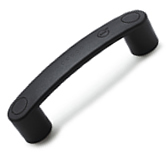
Silver doesn’t just offer a lustrous and shiny appearance; it has antimicrobial properties that protect it from bacteria, fungi and viruses. You can often find pull handles, hinges and other objects made of silver for this very reason. With a silver construction — or even a silver coating — objects become antimicrobial. To learn more about the antimicrobial properties of silver, keep reading.
What Is Antimicrobial?
Antimicrobial is defined as the ability to neutralize, kill or inhibit the spread of microorganisms. Microorganisms, of course, consists of bacteria, fungi and viruses. While you may not be able to see them, microorganisms are all around us. Most of them are harmless. Others, however, can cause illness. If an infection-causing microorganism lands on an antimicrobial object, it won’t be able to reproduce. The antimicrobial properties of the object will typically kill it. Therefore, you’ll be able to safely use the object without fear of becoming injected.
Why Silver Is Antimicrobial
There are dozens of antimicrobial materials, some of which occur naturally while others are manmade. Silver falls under the former category. Silver is a metal that naturally exhibits antimicrobial properties. Silver has actually been used for centuries to stop the spread of infectious illnesses. It consists of positively charged ions — Ag+ silver ions — that neutralize microorganisms.
Most silver antimicrobial coatings contain three components. They have the aforementioned silver ions, silver zeolite and an ion exchange. The ion exchange acts as the release mechanism. It’s responsible for releasing the silver ions into the surrounding environment. The silver zeolite serves a similar purpose, but it allows for the release of the silver ions in humid and moist environments. As humidity and moisture increase, more of the silver ions will be released. This is important because humidity and moisture typically encourage microbial growth. Therefore, additional protection is needed in humid and moist environments.
The Benefits of Silver-Based Antimicrobial
Being that there are other antimicrobial materials available, you might be wondering what makes silver such an effective choice. For starters, silver can be easily manipulated into custom shapes and sizes. Whether you’re shopping for a pull handle, a hinge, etc., you can probably find it in silver. Many of these parts can also be manufactured with a silver coating, meaning the silver is applied as a thin protective layer over the part.
Silver is also highly effective as neutralizing microorganisms. It’s believed that microorganisms ingest the silver ions. And when they do, the silver ions destroy the inner walls of their cells, essentially causing them to break down from the inside out.
Silver also has oxidative properties, which may further improve its antimicrobial performance. The silver ions will oxidize when exposed to oxygen, which can cause cellular respiration failure in microorganisms.
